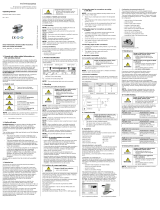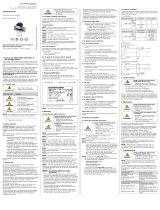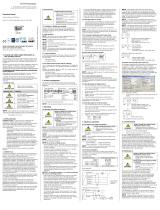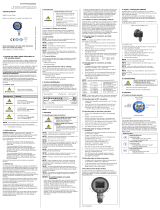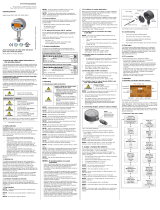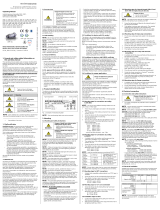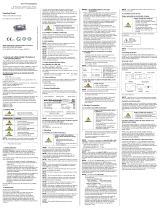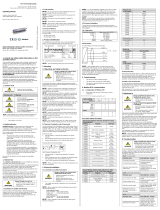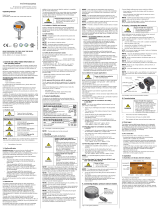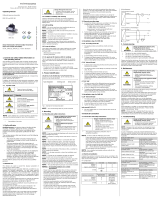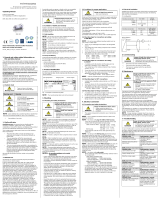Page is loading ...

BD-Sensors-Str.1; 95199 Thierstein
Phone: +49 (0) 9235 9811 0 | www.bdsensors.com
EN
© 2016 BD|SENSORS GmbH
Translation of the original instructions
Piezoelectric sensors
DAC XXX
READ CAREFULLY PRIOR TO USE
RETAIN FOR FUTURE REFERENCE
ID: BA_DAC_E | Version: 06.2016.0
1 General information about these operating
instructions
These operating instructions allow safe, appropriate use of the
product.
The operating instructions are part of the device and should be
kept accessible to personnel at all times in the immediate vicinity
of the installation location of the device.
Any person charged with setting up, commissioning, or
operating the device must have read and understood the
operating instructions, particularly the safety-related instructions.
The data sheet for the individual sensor is an important part
of the operating instructions:
Specific data on individual sensors can be found in the
corresponding data sheets.
If you do not have a data sheet, request one at:
[email protected] | Tel: +49 (0) 9235 9811 0
Compliance with the applicable accident prevention regulations
and safety regulations as well as with national installation
standards and recognized codes of practice must also be
ensured.
1.2 Symbols used
Warning term
- Nature and source of danger
- Measures to prevent danger
Warning term
Meaning
DANGER
- Immediate danger!
- Failure to observe will result in death
or serious injury.
WARNING
- Possible danger!
- Failure to observe may result in
death or serious injury.
CAUTION
- Dangerous situation!
- Failure to observe may result in slight
or moderate injury.
NOTE
– calls attention to a potentially dangerous situation
that can result in property damage if not observed.
1.3 Qualification of personnel
Qualified persons are persons who are charged with setting
up, installing, repairing, and operating the product and who are
appropriately qualified for their tasks.
This includes persons who meet at least one of the following
prerequisites:
- They are familiar with safety concepts in measurement and
automation and they are charged with them as project
personnel.
- They are operating personnel for measurement and
automation systems and have been instructed in the use of
the systems. They are charged with operating the devices
and technologies described in this documentation.
- They are commissioners or assigned to service and have
completed technical education that enables them to repair
the system. They also have the authorization to
commission, to ground, and to label electrical circuits and
devices in accordance with the standards of safety
engineering.
1.4 Limitation of liability and warranty
Failure to follow the instructions or observe technical
regulations, improper use or use of the device in a manner other
than that intended, or alteration or damage to the device will void
the warranty and invalidate claims for liability.
1.5 Intended use
WARNING
Risk of injury
- Due to unintended use
- Use the device as intended.
The device may be used exclusively for measurement tasks and
directly associated control tasks within the limits of use specified
in the technical data. Any other use is considered unintended.
It is the responsibility of the user to check whether the device is
suitable for the chosen application. If in doubt, please contact
our sales office ([email protected] | Tel: +49 (0) 9235 9811 0).
BD SENSORS cannot, however, assume any liability for an
incorrect choice or any consequences arising from this!
Media that can be measured are gases or liquids that are
compatible with the materials that contact the medium. These
are described in the data sheet. Furthermore, it must be ensured
in each individual case that the medium is compatible with the
parts that come into contact with it.
1.7 Package contents
Check that all of the listed parts are included in the delivered
package and have been supplied in accordance with your order:
- Device DAC XXX
- Protective caps
- User manual
- Data sheet
2. Product Identification
The model and serial number are marked on the device for
identification purposes.
Fig. 1 Sensor markings
3. Warnings and safety instructions
WARNING
Risk of injury
- In case of use other than intended or
suitable
- Only qualified personnel may use and
apply the sensors
WARNING
Risk of injury
- Internal or external arcing due to
mechanical or thermal effects
- Always use the sensor in conjunction
with a charge amplifier.
NOTE– Use only certified or approved tools, accessories (e.g.,
thermal shields, cables, etc.) and appropriate resources for
installation and commissioning.
NOTE– Repairs or modifications to the sensors and
accessories may be performed only by the manufacturer, or by
qualified personnel in discussion with the manufacturer.
NOTE– During operation, an expert must ensure that the test
equipment and test object are not subjected to any conditions
that could lead to property damage or personal injury.
NOTE– Do not throw the device.
NOTE– Measurement accuracy depends not only on the
sensor itself, but also on a series of conditions that cannot be
influenced by the manufacturer. Measurement results must
therefore be interpreted by experts and reviewed for plausibility
before additional steps or measures are defined on the basis of
them.

4. Installation and operating
NOTE– Specific data on individual sensors can be found in the
corresponding data sheets.
Single-channel measurement chain with charge amplifier:
Example:
Figure 2 Measurement chain with charge amplifier
• Always store the sensors in a dry place, together with the
provided silica gel, if needed.
• In order to ensure sensor insulation, the plug must be
kept clean and dry.
• Plug contacts must be protected against corrosion and
corrosive gases.
• The sensor membranes must be protected against
mechanical effects. Scratches or deformities on the
membrane can irreversibly degrade the measurement
accuracy.
• The sensors must not be exposed to any conditions
(pressure, force, temperature, acceleration, or strain)
beyond their specified working range.
• The sensors must be installed such that no undesired
artifacts can influence the measurement (e.g., standing
waves, noise.)
• Prior to installation, the mounting hardware must be
checked for appropriate dimensions and general
condition.
• All dimensions, tolerances, and roughness of the sensor
mount can be found in the corresponding data sheets
and must be followed.
• Seals, sealing surfaces, and threads on the sensor and
the sensor mount must be free of visible defects.
• The sensor must be connected to the measured medium
via the surfaces intended for this purpose (membranes,
pressure pads, etc.)
• Any frictional connection not defined by correct
installation and operation of the sensor must be avoided.
• If sensors are modified or adapted after installation, such
as the pressure pad and protective sleeve for injection
molding applications, then undesired deformation or
shear forces must be avoided. Any wear debris from
modifications must be removed and must not get
between the pad and the sleeve. The same applies for
low-viscosity injection molding, which can also cause
additional frictional contact between the pad and sleeve.
• Sensors emit heat through the threads and seals, so
these must allow conductive transfer and undesired heat
inputs must be avoided.
• For water-cooled sensors, care must be taken that the
cooling is switched on and running reliably prior to
commissioning the motor, test bench, or the like. Use
only distilled water in order to prevent scale buildup. Use
only the intended seals.
• When using flam protection, take note that the
thermodynamic precision and protection of the sensor
are only improved if it is free of deposits such as soot
and other particles. For these reasons, it is
recommended that flame protection be cleaned regularly
and fundamentally not used with diesel engines.
• The sensors must be mounted using torque wrenches in
compliance with the torque indicated in the data sheet.
• For pressure measurements, the leak tightness of the
sensor installation must be checked before
commissioning the system. Any differences in thermal
expansion coefficients of the sensor, the seal, and the
mount must be considered.
• It must be ensured that no moving parts can come into
contact with the sensor or cable.
• Cables must be strain-relieved and routed with
appropriate bend radii. If the sensor is mounted on
moving parts, then the cable must be freely able to
compensate for the motion.
• Mechanical and electromagnetic loads on the cable must
be avoided and the temperature must be within the
permissible range.
• Cables must not be shortened or repaired.
• Shielded sensors must be used with appropriate
amplifiers. If the shielding is not grounded, electrical
interference signals could falsify the measurement.
• Route cables at a sufficient distance from power cables.
5. Decommissioning
WARNING
Risk of injury
- In case of use other than intended or
suitable
- Installation to be performed only by
technical personnel
DANGER
Danger to life
- Projectile parts, escaping medium,
electrical shock
- Remove the device only when the
machine is depressurized and the
power supply has been switched off!
Caution
Risk of injury
- From aggressive media.
- Wear suitable protective clothing, e.g.
gloves, goggles.
NOTE – After removal, mechanical connections must be
covered with protective caps.
6. Maintenance
WARNING
Risk of injury
- Incorrect maintenance can cause
damage
- Maintenance must be performed by
qualified personnel
- Wear suitable protective clothing, e.g.
gloves, goggles.
The device is, in principle, maintenance free.
Do not remove contaminants such as soot mechanically;
instead, use a basic cleaning fluid suitable for the material in
question.
NOTE– Incorrect cleaning can result in irreparable damage to
the measuring cell. For this reason, you should never use sharp
objects or compressed air to clean the diaphragm.
7. Servicing/Repair
Return
For any return, such as for repair, clean the device carefully and
package it to prevent damage. The device must be
accompanied by a notice of return giving a detailed description
of the fault. If your device has come into contact with pollutants,
then a notice of decontamination will also be needed. You can
find the relevant templates on our website. Download them from
www.bdsensors.de or request them from: info@bdsensors.de |
Tel: +49 (0) 9235 9811 0
If you send in your device without a notice of decontamination
and doubts with regard to the medium used should arise in our
service department, repair work will commence only once an
appropriate notice has been received.
8. Disposal
WARNING
Risk of injury
- From hazardous materials
- Disposal only by technical personnel
- Wear suitable protective clothing, e.g.
gloves, goggles.
The device must be disposed of in accordance with European
Directives 2012/19/EC (Waste Electrical and Electronic
Equipment). Waste electrical products may not be disposed of
with household waste!
NOTE – Dispose of the device properly.
9. Guarantee Conditions
The guarantee conditions are subject to the statutory warranty
period of 24 months, starting from the date of dispatch. No
warranty claims will be accepted if the device has been used
improperly, modified or damaged. The warranty does not cover
damaged diaphragms. Warranty cover also excludes any claims
for defects that have arisen as a result of normal wear.
/
